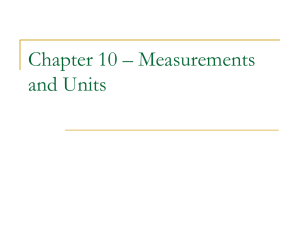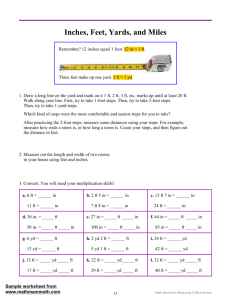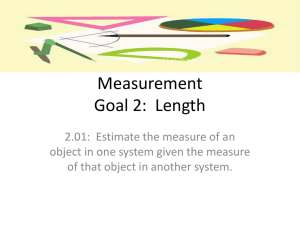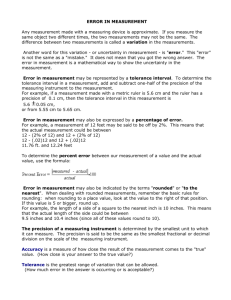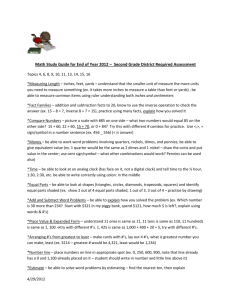Unit Conversions
advertisement
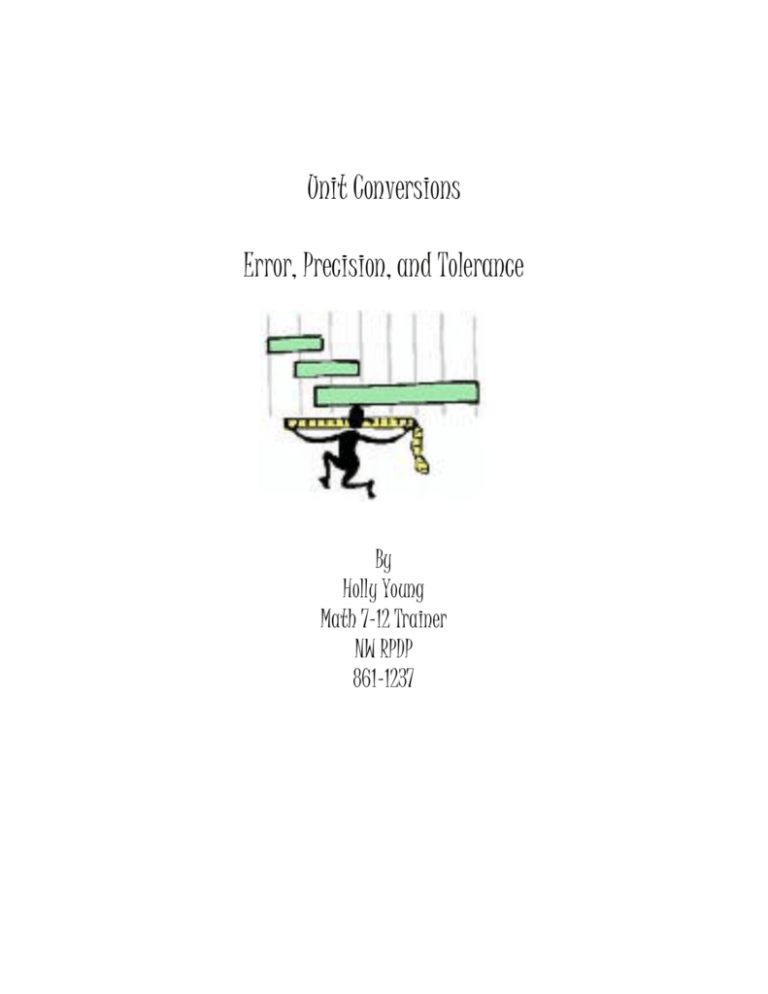
Unit Conversions Error, Precision, and Tolerance By Holly Young Math 7-12 Trainer NW RPDP 861-1237 Essential Understandings: Can you estimate the conversion between customary and metric systems? Can you convert between customary and metric systems? Unit Conversion: Warm-up: Give the students the three stacks of color-coded cards: length, capacity, weight/mass. Have them put the cards in three rows, in order from smallest to biggest, keeping colors together. After the students feel that they have the cards in the correct order, give them a few conversion tools (rules, dropper, etc) and let them make changes from examining the tool. After the following notes are given on conversions, the students can try to find the answers for themselves and check their estimations. You have learned that: The X is a variable. So X . 1 = __1x___ A variable can be any number. 382 . 1 = _382_____ and 12 miles . 1 = __12 miles________ (label) Anything times 1 is equal to itself. You also learned that: 1/1 = _1____ and And feet/feet = 1. 5/5 = __1_____ and 10/(5.2) = __1______ and eggs/eggs = 1 Anything divided by itself or by something that is equal to itself is equal to 1. Therefore if two things are equal and you make a fraction out of them (divide one by the other) it will always equal 1. By combining these 2 statements it should be clear that if you multiply something by a fraction made from two things that are equal to each other, then you’re are not changing the value of the number that you started with. 12 inches = 1 foot therefore if you multiply something by 12 inches/1 foot you will have something that is equal to what we started with. You have simply converted it to a different unit. It is the same length but different measuring units. Example: 4 feet 12 inches 1 foot = 48 inches Since 4 feet is equal to 48 inches you simply multiplied by a form of 1 and in the process you changed the units (inches to feet). Since there was a foot on the top and a foot on the bottom they cancel each other out just like numbers do leaving inches as the unit that labels the answer. Start with 60 inches and use the same method to convert to feet. Fill in the blank. 60 inches X ________ = 5 feet 60 inches = HINT: 12 inches belongs on the bottom so that they can cancel. It is okay to put the inches on top and the feet on the bottom or the other way around but the 12 stays with the inches whether it is on the top or the bottom. If there are 3 feet in one yard, convert 27 feet to yards, using this set up. = Sometimes it is necessary to do two or more conversions, because you don’t know the exact conversion if a unit is two parts away, say from hours to seconds, but you know hours to minutes and minutes to seconds. Now try a two step unit cancellation problem . HAND OUT CONVERSION TABLES! Suggestion – it would probably help students to make 3 sets of flashcards – customary, metric, and conversions. Have them make cards for each 1inch , this way they can search for the card to fit into conversion, but make it as a fraction – like 2.54cm the conversion. Have them put the reciprocal on the back of the flashcard. How many inches are there in 6 yards? Do both conversions in one problem. Start with the 6 yards and convert them to feet, then convert feet to inches. 6 yards 3 feet 1 yard 12 inches 1 foot = Make sure that you cancel anything that is on the top and the bottom and solve the problem. Student Worksheet 1. How many inches in 5 feet? Conversion? 5 feet = inches 2. How many yards are there in 22 feet? Conversion? 22 feet = yards 3. How many miles are there in 8000 feet? Conversion? 8000 feet = miles 4. How many inches are there in 4 yards? Conversion Conversion 4 yards = inches 5. How many ounces are there in 6 cups? Conversion Conversion (if needed) 6 cups = ounces 6. How many quarts are in 7 gallons? Conversion Conversion (if needed) 7 gallons = quarts 7. How many cups are in 6 quarts? Conversion Conversion (if needed) 6 quarts = cups 8. How many feet are in 6 meters? Conversion Conversion (if needed) 6 meters = feet 9. How many grams are in 14 oz? Conversion Conversion (if needed) 14 oz = grams Answers to the card ordering activity: Length: 6 mm < ¼ inch < 2 cm < 1 ft < 1 yard < 1 meter < 1 km < 1 mile Capacity: 1 tbls < 4 tsp < 1/8 cup < 30 mL < 1 pint < ½ L <1 quart < ½ gallon Weight/Mass: 1 ounce < 30 grams < 35,000 mg < 2 lbs < 1 kg < 1 tonne < 1 ton Challenge for upper level students – converting two or more units in one problem. Rex was traveling at 15 miles per hour on his bike. What is his rate in feet per second? 15 miles 1 hour 1 minute 5280 feet = 79200 feet Hour 60 minutes 60 seconds 1 mile 3600 second Reducing the answer would give 22 feet/second. More examples: a) Traci’s stopwatch records time in meters per minute. If her dog ran at a speed of 18 meters per minute, what is his speed in miles per hour? Answer: .67107 mph b) A pool drains at a rate of 22 gallons per hour. What is its rate in liters per minute? Answer: 1.38798 L/minute Homework: (1) Worksheet of problems. Answers: 1) 12 pints, 2) 27.5 cm, 3) 24 oz sugar, 1/3 oz vanilla, 4) 102.8403 m2 and $308.52 (2) The measurement contract. (3) Additional class project or extra credit opportunity. HOMEWORK WORKSHEET NAME: ____________________ Remember to show all of your work! 1) Glenn needs 6 quarts of Cool-Aid for a recipe, but it only comes in pints. How many pints must Glenn purchase to get the 6 quarts of Cool-Aid that he needs? = __________________ 2) If there are about 2.5 centimeters in 1 inch, how many centimeters would there be in 11 inches? = __________________ 3) A recipe calls for 3 cups of sugar and 2 tsp vanilla. If you only have a measuring cup with ounces marked, how many ounces of sugar and vanilla would you put in the recipe? = _sugar____________ = _vanilla___________ 4) A European carpet company sells carpet at $3 per square meter. You only have a yard stick to measure your floor which came out to be 123 square yards. How large is the room in square meters and how much will it cost to re-carpet? = __room = ____________ __cost to re-carpet = ________ Make up your own problem in this space. Make sure it is not the same as the problems above! Calculate your answer on the back of the paper, but make sure it is written at the bottom of the page (we will be cutting these problems out and exchanging them). 12inches 1 foot 3 feet 1 yard 1hour 60 min utes 1.0936 yd 1meter 1mile 1760 yd 8oz 1cup 1tbl 3tsp .5oz 1tbl 3.7854 L 1gallon .8361m 2 1yd 2 1 foot 1 yard 1 mile 1 meter ¼ inch 1 kilometer 2 cm 6 millimeters Length Length Length Length Length Length Length Length 30 mL 1 pint 4 tsp 1 quart ½ gallon 1 tablespoon 1/8 cup ½ Liter 2 lbs 35,000 mg 1 ton 1 tonne 30 grams 1 kg 1 ounce Capacity/Volume Capacity/Volume Capacity/Volume Capacity/Volume Capacity/Volume Capacity/Volume Capacity/Volume Capacity/Volume Mass/Weight Mass/Weight Mass/Weight Mass/Weight Mass/Weight Mass/Weight Mass/Weight Mass/Weight Weight/Mass Cards: Which cards are causing problems (mark with a star underneath): Here is my work: This is what I learned as I was ordering the cards or when I was doing calculations: Weight/Mass CONVERSION BETWEEN METRIC AND CUSTOMARY LENGTH Metric 1 millimeter (mm) 1 centimeter (cm;=10mm) 1 meter (m; = 100 cm) 1 kilometer (km;=1,000m) Customary 0.0394 in 0.3937 in 1.0936 yd 0.6214 mile Metric 1 cm² (=100mm²) 1 m² (=10,000 cm²) 1 hectare (ha; = 10,000m²) 1 km² (= 100 ha) Customary 0.1550 in² 1.1960 yd² 2.4722 acres 0.3861 mile² Customary 1 inch (in) 1 foot (ft; - 12 in) 1 yard (yd; = 3 ft) 1 mile (=1760 yd) Metric 2.54 cm 0.3048 m 0.9144 m 1.6093 km Customary 1 in² 1 ft² (=144 in²) 1 yd² (=9 ft²) 1 acre (=4840 yd²) 1 mile² (=640 acres) Metric 6.4516 cm² 0.0929 m² 0.8361 m² 4046.9 m² 2.59 km² Customary 1 in³ 1 ft³ (=1,728 in³) 1 US fl oz 1 pint (17 fl oz) 1 US gallon Metric 16.387 cm³ 0.0283 m³ 29.574 ml 0.4731 L 3.7854 L Customary 1 ounce 1 pound 1 ton Metric 28.35 g 0.4536 kg l.016 t AREA VOLUME/CAPACITY Metric 1 cm³ 1 dm³ (=1,000cm³) 1 m³ (=1,000 dm³) 1 liter (L; = 1 dm³) 1 hectoliter (hl; = 100 L) Customary 0.0610 in³ 0.0353 ft³ l.3080 yd³ 1.76 pt 21.997 gal Metric 1 milligram (mg) 1 gram (g; = 1,000 mg) 1 kilogram (kg; = 1,000 g) 1 tonne (t; = 1,000 kg) Customary 0.0154 grain 0.0353 oz 2.2046 lb 0.9842 ton (T) MASS/WEIGHT TIME TO COOK! Given the one measurement tool that you have, you will need to make the following recipe. Write all your conversions on this page, then make your yummy dip! Creamy dill dip: 1 4 oz package cream cheese softened 1 4 oz carton dairy sour cream 1 tablespoon finely chopped green onion 1 teaspoon dried dillweed ¼ teaspoon seasoned salt Mix and eat! Conversions: 1) 2) 3) 4) 5) TIME TO COOK! Given the one measurement tool that you have, you will need to make the following recipe. Write all your conversions on this page, then make your yummy dip! Fluffy peanut butter dip: ¼ cup creamy peanut butter ½ container (4 ounces) vanilla yogurt 1/16 teaspoon ground cinnamon ¼ cup thawed frozen whipped topping Mix and eat! Conversions: 1) 2) 3) 4) Can you estimate the conversion between customary and metric systems? Fold a paper into thirds. Measure ten objects with a metric ruler. Write your measurements in the left column. In the middle column, estimate how many inches the object would be. In the right column put the actual measurement in inches. Write a paragraph describing how well you estimated. Create a poster that shows 5 pictures of common items being used to compare a customary and metric unit measure. Example: 1 finger joint = 1 inch Width of fingernail = 1 cm. Can you convert between customary and metric systems? Make up 10 conversion problems with a separate answer key. Three of the problems must require 2 steps to convert. Exchange the problems with someone else, then check with the answer key. The person who did your problems must show their work and sign their name. Write a recipe on how to convert a metric measurement to a customary measurement. You need to have 3 examples of conversions in your recipe. One example must be a 2 step conversion. Name _______________________________ MEASUREMENT CONTRACT Directions: Chose 1 task for each shape. Two options are given to you for each. Use the information from your notes and conversion sheets. When you are finished, paste the shapes you chose to complete on this paper. Project: Investigations into Unusual Units of Measurements We have looked at Customary Units of Measurement (the measurement system used in the United States and the Metric System. However, there are many UNUSUAL units of measurement that are used by a variety of people in their jobs or hobbies. You are going to research one unit of measurement listed below and answer the following questions: 1. What is your unit of measure? 2. What does your unit measure (length, area, volume, capacity, weight, frequency, speed, amount, etc.)? 3. What specific item or purpose is it used for? 4. What is its size definition and/or relationship to other units? 5. What profession of person may use your unit of measure? 6. What are other interesting facts or history about your unit of measure? 7. Where did you find your information? List your resource. 8. Write 2 original problems showing how to convert your unit to something else. Your research needs to be presented on a poster that will be displayed, so quality counts! Measures: Cord, Hogshead, Peck, Carat, Karat, Watt, Bolt, Barrel, Horsepower, Calorie, Rod, Furlong, Hand, Acre, Board Foot, Ream, Hertz, Gross Tonnage, Mach 1, Light Year, Jigger, Gill, Troy Pound, Knot, Quire, Gross, Bit, Nose, Magnum, Lux, Btu, Ampere, Volt, Dram, Rick, Hectare, Byte, Shot, Pica, RPM, Bushel, Mole, Fortnight, Eon, Fathom, Frac, Era, R Factor, Score, Pennyweight, Scruple, Decibel, Farthing, and G Force. Project modified from Just ASK Publications, ASK, Inc. Essential Understandings: Can you justify the precision in practical problems? Can you justify the tolerance in practical problems? Can you differentiate between precision, error, and tolerance in practical problems? Precision, Error, and Tolerance: Students put the definition on the note builder page. Error: The difference between the true value and the measured value based on its quantity, often expressed as either absolute error or relative error. Example: Double stuff Oreos are supposed to have 2 times the filling of regular Oreos. A regular Oreo’s stuffing weighs 1.0 grams, if a double stuff measures 1.8 grams, what is the error? 1.0 x 2 = 2.0 – 1.8 = 0.2 gram error Greatest Possible Error: Half the unit used for measuring. Example: If you are measuring the length of an 18 foot window to the nearest foot, what is the greatest possible error? Answer: 6 inches Precision: The level of detail of a measurement determined by the measurement device or unit. Item specs require the precision items must involve different units to compare. Example: What would be the most accurate measurement for the line segment shown? Answer: 3.9 cm Tolerance: The allowable error in a given measurement. (5.125 +/- .005) is a standard way of writing tolerance. This also referred to as margin of error in statistics. At the 8th grade level problems may not use the plus/minus symbol. Example: The Oreo company has allowed only a plus or minus 0.25 oz tolerance for error on the weight of 3.5 oz cookies. Give a weight that is within the acceptable error tolerance range and give a weight that is not in the range. Answer: In the range 3.53oz and not in the range 3.20 oz. Student Practice Problems Name: ___________________ Greatest Possible Error: 1) If you are measuring candy to the nearest gram, what is the greatest possible error? ______________ 2) You are measuring liquid for a 32 L chemistry experiment to the nearest liter, what is the greatest possible error? ______________ Precision: 3) Using the ruler below, which line segment is closest to 1.8 centimeters in length? ______________ 4) Which measurement has the most precision – 4.0 in, 2 feet, 6.0 feet, 1.0 yard? ______________ 5) Which measurement has the most precision – 2 cm, 3 mm, 1 inch, 3 feet, 3.2 mm? ______________ Tolerance: 6) When producing ½ inch bolts for bicycle parts, the tolerance is 0.005 inch. What is the range of acceptable bolt measures? _______________ 7) For a chemistry project, Marvin must pour 3.25 milliliters of liquid into a beaker. If he does not pour within 0.05, inclusive, of 3.25 milliliters, the results will be inaccurate. How many milliliters of liquid can Marvin use? _______________ 8) Every measuring device has a limitation. For example, a mercury thermometer can normally read temperature only to the nearest degree Celsius. Therefore, a reading of 25o C should then be written as (25 ± 0.5)o C because it can be any value between 24.5o C and 25.5o C due to its limitation. If a yard marker in football is accurate to the nearest inch, then how far does a team need to go if the announcer says it is first down and ten yards to go? (don’t forget to convert inches to yards!) _______________ 9) In an article printed in the Reno Gazette-Journal dated November 21, 2007, a statistical match-up was provided giving Hillary Clinton 44% of the vote and Rudy Giuliani 45%. The quote reads, “…less than 3 points separate each Republican from each Democrat in the general election scenarios. That’s well within the poll’s 5 percent margin of error.” According to this given margin of error or tolerance, what is Hillary Clinton’s actual approval range, and what is Rudy Giuliani’s actual range? _______________ Answers to the student practice problems: 1) 0.5g 2) 0.5 L 3) CD 4) 4.0 inch 5) 3.2mm 6) 0.495 – 0.505 7) 3.20-3.30 8) 9.98612 – 10.01388 yards 9) Clinton: 39-49% Guiliani: 40-50% Carrot Measuring activity. Each student group (or partner set) needs approximately 10-12 carrots. In order to get an accurate rating a postal measuring device or a chemistry scale is needed. First, students receive only 1 carrot to work with – designate a measurer in the group if you are limited on the number of scales available. The measurer gets an accurate measure on this one carrot. From that carrot, the group needs to determine an error of tolerance for a bag of baby carrots. Make sure that they are not making the range too large or too small. Once they have determined their acceptable range, given them the rest of their carrots from which they will need to weigh and record. Using their tolerance range, they need to highlight the carrots that will not be accepted into the bag. Students will need to calculate the percent of carrots that were accepted in their bag. Now, you are going to set a rule that 91% of carrots in their collection must be allowed into the bag. What must the tolerance range be changed to make this happen? Using the students’ original tolerance range choice, if the number of carrots was increased by how ever many carrots it takes to get to 20 total carrots, give the possible weights of those carrots to get to 91% acceptance. Homework/project options: 1) Worksheet 2) Bloom’s Tic-Tac-Toe Answers to worksheet: 1) 6 inches, 2) EF, 3) 6 mL, 4) 3.42-3.38, 5) True, the tolerance would be 22-26% and 25% or ¼ falls in that range. Homework Problems Name: ___________________ 1) If you are measuring curtains to the nearest foot, what is the greatest possible error? ______________ 2) Using the ruler below, which line segment is closest to 2.12 centimeters in length? ______________ 3) Which measurement has the most precision – 4L, 6mL,1 pint, or 3 quarts? ______________ 4) When producing 3.4 inch wheels for skateboards, the tolerance is 0.02 inch. What is the rage of acceptable wheel measures? _______________ 5) In an article printed in the Reno Gazette-Journal dated November 21, 2007, students were surveyed to see if their parents asked where they were going when they went out with friends. The survey reported that 24% of students said that their parents asked with a 2% margin of error. According to this tolerance provided, explain whether or not the following statement is true: “One quarter of the students surveyed have parents that ask where they are going when they go out”? Note-taker on Error Essential Questions: Can you justify the precision in practical problems? Can you justify the tolerance in practical problems? Can you differentiate between precision, error, and tolerance in practical problems? Vocabulary Word Definition Example Combine 3 or more of the vocabulary words into 1 sentence that shows their meaning and how they relate to each other. WHAT MAKES A BABY CARROT? Measurement of original carrot: ________________ In order to have a fairly uniform bag of baby carrots, what would be a good tolerance range for a bag? ______________ Measure the rest of your carrots and put the results in the table: Carrot # 1 2 3 4 5 6 7 8 9 10 11 Weight? Acceptable? What is the percent of carrots that were accepted into your bag? The rule at ACME CARROT CO. is that 91% of carrots must be allowed into the bag. What must the tolerance range be changed to in order to make this happen? Using your original tolerance range that you chose, if the number of carrots was increased until there were 20 total carrots, give the possible weights of those carrots to get to 91% acceptance. Error, Precision, & Tolerance Tic-Tac-Toe Directions: You must complete a “tic-tac-toe” of boxes. You can choose to complete a row, a column, or a diagonal. Make sure to include this page with the boxes you chose circled. Find an article in the newspaper or on Design an experiment where you Write and illustrate a carton about a the internet using a survey that mentions measure 20 objects with varying length. superhero named Tolerance. Make sure the margin of error. With the statistics Record your measurements. Set a that your cartoon shows the Math meaning given, provide a range of values that the tolerance to accept only 48% of the of the word Tolerance and how it is used. survey could have as a result, using its objects. Describe your tolerance and Don’t forget that superheroes have special given margin of error. Include a copy of show how you found it. List the powers – so what is Tolerance’s special the article with your range of values. measurements that are not accepted. math power? Design a wanted poster for Precision. A newspaper reporter took the FCC to The following measurements were recorded Make sure that your wanted poster court stating that when a newspaper for the diameter of the wheels of a describes the facts and characteristics of shows a survey result, they shouldn’t be skateboard in centimeters: Precision in its math meaning. required to mention the margin of error 5.012,5.001,5.023,5.007,5.021,5.008,5.013, Creatively give an original example. because it doesn’t matter. Write a letter 5.003,5.015,5.022,5.017,5.009,5.010,5.001 Illustrate your poster! I expect quality! to the reporter proving how wrong that Create a tolerance for the measurement if could be. Make sure to provide an 80% of the wheels must be accepted. example to prove your point. Show all your work. List which measurements are accepted and which are rejected. With a measuring tape, measure the Make a visual dictionary entry for the Find 5 examples in measurement where width of 14 peoples’ thumbnail. Record following words: error, greatest possible using the greatest possible error would not your measurements in centimeters, with error, precision, and tolerance. cause any major problems. Find 5 a precision to the tenths place. Now Remember a visual dictionary doesn’t examples where using the greatest possible record the measurements with a have words that are in the definition, error could cause catastrophic results. precision to the nearest centimeter. If instead, it explains the words in pictures Make sure to explain what is being the average person has a thumbnail only. measured and discuss the measurement width of 2 cm, explain which thumbnails unit. At least two sentences should be don’t fit into the set using the greatest written for all 10 examples explaining why possible error. the greatest possible error is or isn’t a major problem. Example: tiger



